The Hydrological and Mechanical Effects of Forests on Hillslope Soil Moisture Changes and Stability Dynamics
Abstract
1. Introduction
2. Materials and Methods
2.1. Study Area
2.2. Methods
2.2.1. Climatic Data and Soil Moisture Observation
2.2.2. Slope Stability Simulation
2.2.3. Soil Sample Measurements
2.2.4. Root Samplings
3. Results
3.1. Soil Moisture Response
3.2. Physical Properties of Soil Mass and Plant Roots
3.2.1. Physical Properties of Soil Samplings
3.2.2. Plant Roots
3.3. Stability Fluctuation
3.3.1. Fs Proportions
3.3.2. Fs Fluctuation
4. Discussion
4.1. Stability Proportion
4.2. The Changing of Hillslope Stability
5. Conclusions
- Based on the soil moisture changes, the Phyllostachys pubescens forest has the greatest moisture resistance capability, followed by shrub forest, mixed forest and evergreen broadleaf forest.
- The roots of the Phyllostachys pubescens forest have a higher number and deeper distribution, providing a larger additional cohesion than the other three forest types although the root tensile strength is not stronger among the main plant species in the four slope lands.
- The Fs fluctuation indicates that some steep slopes covered by mixed forest and evergreen broadleaf forest in the study area may have a higher failure potential, if the slope landslide is affected by prolonged antecedent precipitation and intensive rainfall events. The Phyllostachys pubescens forest may be considered the most suitable type for protecting steep hillslopes in forest management implementation.
Author Contributions
Funding
Data Availability Statement
Conflicts of Interest
References
- Francis, J.R.; Wuddivira, M.N.; Farrick, K.K. Exotic tropical pine forest impacts on rainfall interception: Canopy, understory, and litter. J. Hydrol. 2022, 609, 127765. [Google Scholar] [CrossRef]
- Garg, A.; Coo, J.L.; Ng, C.W.W. Field study on influence of root characteristics on soil suction distribution in slopes vegetated with Cynodon dactylon and Schefflera heptaphylla. Earth Surf. Process. Landf. 2015, 40, 1631–1643. [Google Scholar] [CrossRef]
- Liu, C.X.; Wang, Y.J.; Ma, C.; Wang, Y.Q.; Zhang, H.L.; Hu, B. Quantifying the effect of non-spatial and spatial forest stand structure on rainfall partitioning in mountain forests, Southern China. For. Chron. 2018, 94, 162–172. [Google Scholar] [CrossRef]
- Norris JSStokes, A.; Mickovski, S.B.; Cammeraat, E.; van Beek, R.; Nicoll, B.C.; Achim, A. Slope Stability and Erosion Control: Ecotechnological Solutions; Springer: Doerdrecht, The Netherlands, 2008. [Google Scholar]
- Ng, C.W.W.; Ni, J.J.; Leung, A.K.; Zhou, C.; Wang, Z.J. Effects of planting density on tree growth and induced soil suction. Géotechnique 2016, 66, 711–724. [Google Scholar] [CrossRef]
- Boldrin, D.; Leung, A.K.; Bengough, A.G. Correlating hydrologic reinforcement of vegetated soil with plant traits during establishment of woody perennial. Plant Soil 2017, 416, 437–451. [Google Scholar] [CrossRef]
- Van Stan, J.; Gutman, E.; Friesen, J. Precipitation partitioning by vegetation: A global synthesis. In EGU General Assembly Conference Abstracts EGUGA; Springer Nature: Berlin, Germany, 2020. [Google Scholar]
- Lin, M.; Sadeghi, S.; Stan, J. Partitioning of Rainfall and Sprinkler-Irrigation by Crop Canopies: A Global Review and Evaluation of Available Research. Hydrology 2020, 7, 76. [Google Scholar] [CrossRef]
- Simon, A.; Collison, A.J.C. Quantifying the mechanical and hydrologic effects of riparian vegetation on streambank stability. Earth Surf. Process. Landf. 2002, 27, 527–546. [Google Scholar] [CrossRef]
- Fan, C.C. A displacement-based model for estimating the shear resistance of root-permeated soils. Plant Soil 2012, 355, 103–119. [Google Scholar] [CrossRef]
- Bordoni, M.; Meisina, C.; Vercesi, A.; Bischetti, G.B.; Chiaradia, E.A.; Vergani, C.; Chersich, C.; Valentino, R.; Bittelli, M.; Comolli, R.; et al. Quantifying the contribution of grapevine roots to soil mechanical reinforcement in an area susceptible to shallow landslides. Soil Tillage Res. 2016, 163, 195–206. [Google Scholar] [CrossRef]
- Fan, C.C.; Chen, Y.W. The effect of root architecture on the shearing resistance of root-permeated soils. Ecol. Eng. 2010, 36, 813–826. [Google Scholar] [CrossRef]
- Li, Y.P.; Wang, Y.Q.; Ma, C.; Zhang, H.L.; Wang, Y.J.; Song, S.S.; Zhu, J.Q. Influence of the spatial layout of plant roots on slope stability. Ecol. Eng. 2016, 91, 477–486. [Google Scholar] [CrossRef]
- Mcguire, L.A.; Rengers, F.K.; Kean, J.W.; Coe, J.A.; Mirus, B.B.; Baum, R.L.; Godt, J.W. Elucidating the role of vegetation in the initiation of rainfall-induced shallow landslides: Insights from an extreme rainfall event in the Colorado Front Range. Geophys. Res. Lett. 2016, 43, 9084–9092. [Google Scholar] [CrossRef]
- Sidle, R.C.; Ziegler, A.D. The canopy interception–landslide initiation conundrum: Insight from a tropical secondary forest in northern Thailand. Hydrol. Earth Syst. Sci. 2017, 21, 651–667. [Google Scholar] [CrossRef]
- Wang, X.H.; Wang, Y.Q.; Ma, C.; Wang, Y.J. Effect of root architecture on soil permeability. Sci. Soil Water Conserv. 2018, 16, 73–82. (In Chinese) [Google Scholar]
- Ghestem, M.; Sidle, R.C.; Stokes, A. The Influence of Plant Root Systems on Subsurface Flow: Implications for Slope Stability. Bioscience 2011, 61, 869–879. [Google Scholar] [CrossRef]
- Damiano, E.; Greco, R.; Guida, A.; Olivares, L.; Picarelli, L. Investigation on rainwater infiltration into layered shallow covers in pyroclastic soils and its effect on slope stability. Eng. Geol. 2017, 220, 208–218. [Google Scholar] [CrossRef]
- Alessio, P. Spatial variability of saturated hydraulic conductivity and measurement-based intensity-duration thresholds for slope stability, Santa Ynez Valley, CA. Geomorphology 2019, 342, 103–116. [Google Scholar] [CrossRef]
- Gonzalez-Ollauri, A.; Mickoski, S.B. Hydrological effect of vegetation against rainfall-induced landslides. J. Hydrol. 2017, 549, 374–387. [Google Scholar] [CrossRef]
- Rodriguez-Iturbe, I.; Porporato, A. Ecohydrology of Water Controlled Ecosystems; Cambridge University Press: New York, NY, USA, 2004. [Google Scholar]
- Laio, F. A vertically extended stochastic model of soil moisture in the root zone. Water Resour. Res. 2006, 42, W02406. [Google Scholar] [CrossRef]
- Liang, W.L.; Kosugi, K.I.; Mizuyama, T. Soil water dynamics around a tree on a hillslope with or without rainwater supplied by stemflow. Water Resour. Res. 2011, 47, W02541. [Google Scholar] [CrossRef]
- Wilkinson, P.L.; Anderson, M.G.; Lloyd, D.M. An integrated hydrological model for rain-induced landslide prediction. Earth Surf. Process. Landf. 2002, 27, 1285–1297. [Google Scholar] [CrossRef]
- Keim, R.F.; Skaugest, A.E. Modelling effects of forest canopies on slope stability. Hydrol. Process. 2003, 17, 1457–1467. [Google Scholar] [CrossRef]
- Lu, N.; Godt, J.W. Hillslope Hydrology and Stability; Cambridge University Press: New York, NY, USA, 2013. [Google Scholar]
- Lu, N.; Likos, W.J. Rate of capillary rise in soil. J. Geotech. Geoenvironmental. Eng. 2004, 130, 646–650. [Google Scholar] [CrossRef]
- Dykes, A.P.; Thornes, J.B. Hillslope hydrology in tropical rainforest steeplands in Brunei. Hydrol. Process. 2000, 14, 215–235. [Google Scholar] [CrossRef]
- Gurevitch, J.; Scheiner, S.M.; Fox, G.A. The Ecology of Plants; Sinauer Press: Sunderland, MA, USA, 2002. [Google Scholar]
- Hubbert, K.R.; Oriol, V. Temporal fluctuations in soil water repellency following wildfire in chaparral steeplands, southern California. Int. J. Wildland Fire 2005, 14, 439–447. [Google Scholar] [CrossRef]
- Lin, H.S.; Kogelmann, W.; Walker, C.; Bruns, M.A. Soil moisture patterns in a forested catchment: A hydropedological perspective. Geoderma 2006, 131, 345–368. [Google Scholar] [CrossRef]
- Pugnaire, F.; Valladares, F. (Eds.) Functional Plant Ecology; CRC Press: Boca Raton, FL, USA, 2007. [Google Scholar]
- Gomi, T.; Sidle, R.C.; Ueno, M.; Miyata, S.; Kosugi, K.I. Characteristics of overland flow generation on steep forested hillslopes of central Japan. J. Hydrol. 2008, 361, 275–290. [Google Scholar] [CrossRef]
- Fan, C.C.; Tsai, M.H. Spatial distribution of plant root forces in root-permeated soils subject to shear. Soil Tillage Res. 2016, 156, 1–15. [Google Scholar] [CrossRef]
- Sanchez-Castillo, L.; Kubota, T.; Hasnawir Cantu-Silva, I. Influence of root reinforcement of forest species on the slope stability of sierra Madre oriental, Mexico. J. Fac. Agric. Kyushu Univ. 2017, 62, 177–181. [Google Scholar] [CrossRef]
- Nespoulous, J.; Merino-Martin, L.; Monnier, Y.; Bouchet, D.C.; Ramel, M.; Dombey, R.; Viennois, G.; Mao, Z.; Zhang, J.L.; Cao, K.F.; et al. Tropical forest structure and understorey determine subsurface flow through biopores formed by plant roots. Catena 2019, 181, 104061. [Google Scholar] [CrossRef]
- Wang, X.H.; Ma, C.; Wang, Y.Q.; Wang, Y.Q.; Li, T.; Dai, Z.S.; Li, M.Y. Effect of root architecture on rainfall threshold for slope stability: Variabilities in saturated hydraulic conductivity and strength of root-soil composite. Landslides 2020, 17, 1965–1977. [Google Scholar] [CrossRef]
- Sidle, R.C.; Ziegler, A.D.; Negishi, J.N.; Nik, A.R.; Siew, R.; Turkelboom, F. Erosion processes in steep terrain—Truths, myths, and uncertainties related to forest management in Southeast Asia. For. Ecol. Manag. 2006, 224, 199–225. [Google Scholar] [CrossRef]
- Pollen-bankhead, N.; Simon, A. Hydrologic and hydraulic effects of riparian root networks on streambank stability: Is mechanical root-reinforcement the whole story? Geomorphology 2010, 116, 353–362. [Google Scholar] [CrossRef]
- Arnone, E.; Caracciolo, D.; Noto, L.V.; Preti, F.; Bras, R.L. Modeling the hydrological and mechanical effect of roots on shallow landslides. Water Resour. Res. 2016, 52, 8590–8612. [Google Scholar]
- Kim, J.H.; Fourcaud, T.; Jourdan, C.; Maeght, J.; Mao, Z.; Metayer, J.; Meylan, L.; Pierret, A.; Rapidel, B.; Roupsard, O.; et al. Vegetation as a driver of temporal variations in slope stability: The impact of hydrological processes. Geophys. Res. Lett. 2017, 44, 4897–4907. [Google Scholar] [CrossRef]
- FAO; ISSS; ISRIC. World Reference Base for Soil Resources; FAO: Rome, Italy, 1998. [Google Scholar]
- Soil Survey Staff. Keys to Soil Taxonomy, 6th ed.; US Department of Agriculture, Soil Conservation Service: Lincoln, NE, USA, 1994; pp. 161–186. [Google Scholar]
- Lu, N.; Godt, J.W. Infinite-slope stability under steady unsaturated conditions. Water Resour. Res. 2008, 44, 1–13. [Google Scholar] [CrossRef]
- Lu, N.; Likos, W.J. Unsaturated Soil Mechanics; Wiley: Hoboken, NJ, USA, 2004. [Google Scholar]
- China National Standards CNS-GB/T50123-1999; Standard for Soil Test Method. Standardization Administration of China (SAC), Ministry of Construction, Ministry of Water Resources. China Planning Press: Beijing, China, 1999. (In Chinese)
- Batse, S.D.; Poesen, J.; Reubens, B.; Wemans, K.; De Baerdemaeker, J.; Muys, B. Root tensile strength and root distribution of typical Mediterranean plant species and their contribution to soil shear strength. Plant Soil 2008, 305, 207–226. [Google Scholar] [CrossRef]
- Preti, F.; Giadrossich, F. Root reinforcement and slope bioengineering stabilization by Spanish Broom (Spartium junceum L.). Hydrol. Earth Syst. Sci. Discuss. 2009, 13, 1713–1726. [Google Scholar] [CrossRef]
- Wu, T.H.; McKinnell, W.P.; Swanston, D.N. Strength of tree roots and landslides on Prince of Wales Island, Alaska. Can. Geotech. J. 1979, l, 19–33. [Google Scholar] [CrossRef]
- Fan, C.C.; Su, C.F. Role of roots in the shear strength of root-reinforced soils with high moisture content. Ecol. Eng. 2008, 33, 157–166. [Google Scholar] [CrossRef]
- Zhu, J.Q.; Wang, Y.Q.; Wang, Y.J.; Zhang, H.L.; Li, Y.P.; Liu, Y. Analysis of root system enhancing shear strength based on experiment and model. Rock Soil Mech. 2014, 35, 449–458. (In Chinese) [Google Scholar]
- Cheng, Y. Mechanism of Water Resources Conservation and Recharge of Forest and Its Ecological FUNCTION value Evaluation in Jinyun Mountain; Beijing Forestry University: Beijing, China, 2007. (In Chinese) [Google Scholar]
- Pérez-Suárez, M.; Arredondo-Moreno, J.T.; Huber-Sannwald, E.; Serna-Pérez, A. Forest structure, species traits and rain characteristics influences on horizontal and vertical rainfall partitioning in a semiarid pine-oak forest from central Mexico. Ecohydrology 2014, 7, 532–543. [Google Scholar] [CrossRef]
- Masi, E.B.; Segoni, S.; Tofani, V. Root Reinforcement in Slope Stability Models: A Review. Geosciences 2021, 11, 212. [Google Scholar] [CrossRef]
- Collison, A.J.C.; Anderson, M.G. Using a combined slope hydrology/stability model to identify suitable conditions for landslide prevention by vegetation in the humid tropics. Earth Surf. Process. Landf. 1996, 21, 737–747. [Google Scholar] [CrossRef]
- Schmid, I.; Kazda, M. Vertical distribution and radial growth of coarse roots in pure and mixed stands of Fagus sylvatica and Picea abies. Can. J. For. Res. 2001, 31, 539–548. [Google Scholar] [CrossRef]
- Waldron, L.J.; Dakessian, S. Soil reinforcement by roots: Calculation of increased soil shear resistance from root properties. Soil Sci. 1981, 132, 427–435. [Google Scholar] [CrossRef]
- Pollen, N.; Simon, A. Estimating the mechanical effects of riparian vegetation on stream bank stability using a fiber bundle model. Water Resour. Res. 2005, 41, 233–245. [Google Scholar] [CrossRef]
- Schwarz, M.; Lehmann, P.; Or, D. Quantifying lateral root reinforcement in steep slopes–from a bundle of roots to tree stands. Earth Surf. Process. Landf. 2010, 35, 354–367. [Google Scholar] [CrossRef]
- Ekanayake, J.C.; Phillips, C.J. A method for stability analysis of vegetated hillslopes: An energy approach. Can. Geotech. J. 1999, 36, 1172–1184. [Google Scholar] [CrossRef]
- Cogan, J.; Gratchev, I.; Wang, G. Rainfall-induced shallow landslides caused by ex-Tropical Cyclone Debbie, 31st March 2017. Landslides 2018, 15, 1215–1221. [Google Scholar] [CrossRef]
- Ma’ruf, M.F. Shear strength of Apus bamboo root reinforced soil. Ecol. Eng. 2012, 41, 84–86. [Google Scholar] [CrossRef]
- Bittellia, M.; Valentino, R.; Salvatorelli, F.; Pisa, P.R. Monitoring soil-water and displacement conditions leading to landslide occurrence in partially saturated clays. Geomorphology 2012, 173–174, 161–173. [Google Scholar] [CrossRef]
- Damiano, E.; Olivares, L.; Picarelli, L. Steep-slope monitoring in unsaturated pyroclastic soils. Eng. Geol. 2012, 137–138, 1–12. [Google Scholar] [CrossRef]
- Harris, S.J.; Orense, R.P.; Itoh, K. Back analyses of rainfall-induced slope failure in Northland Allochthon formation. Landslides 2012, 9, 349–356. [Google Scholar] [CrossRef]
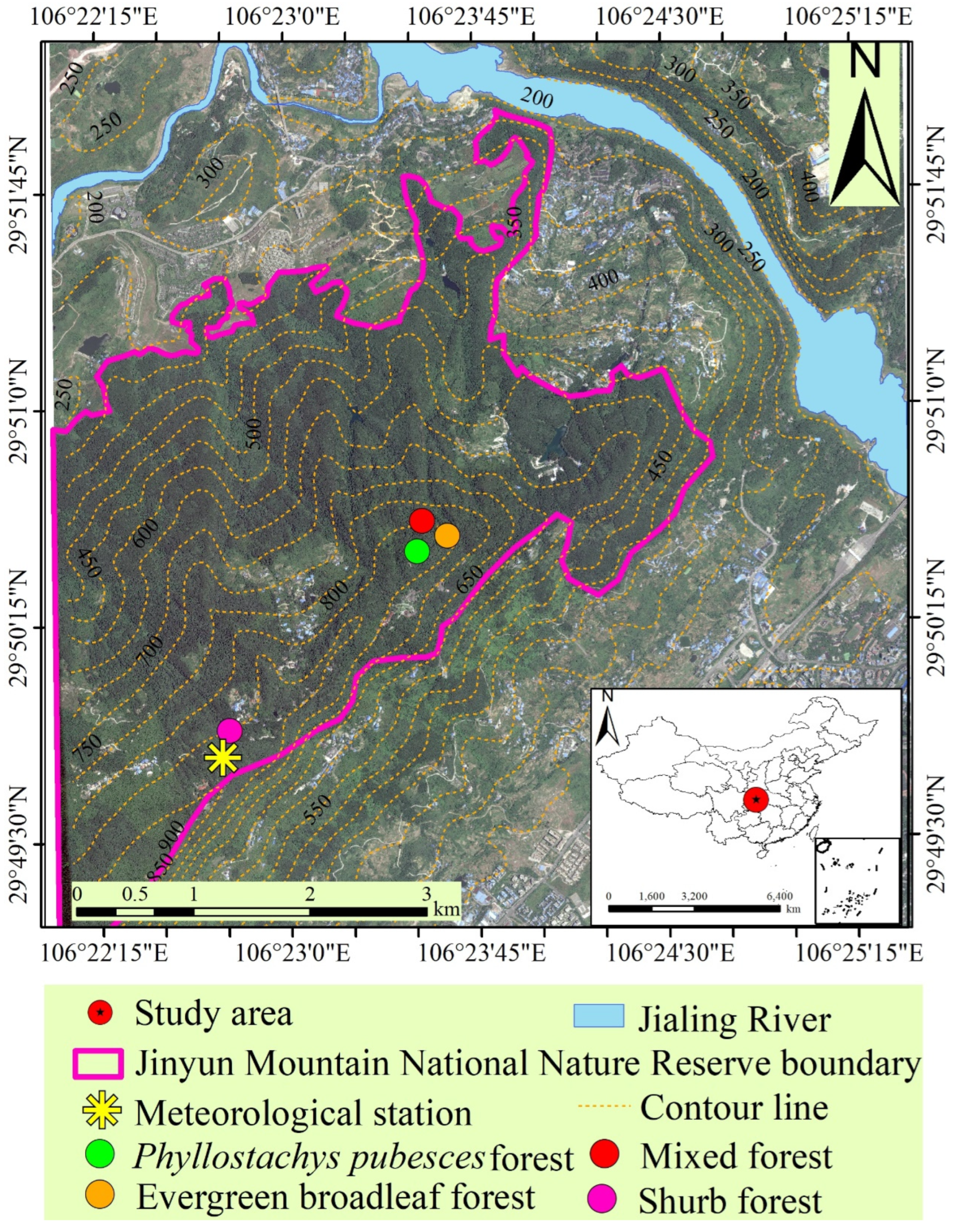
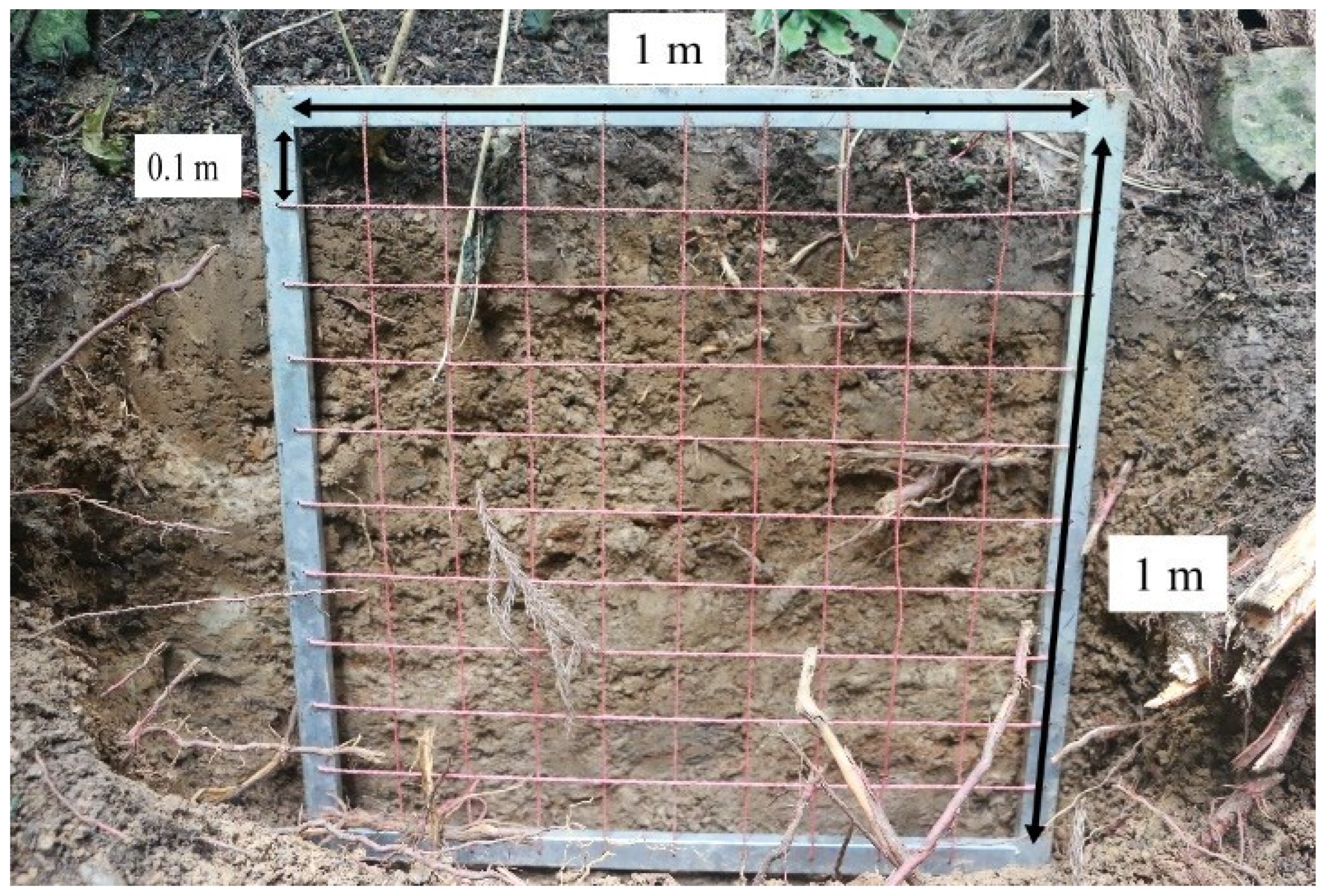
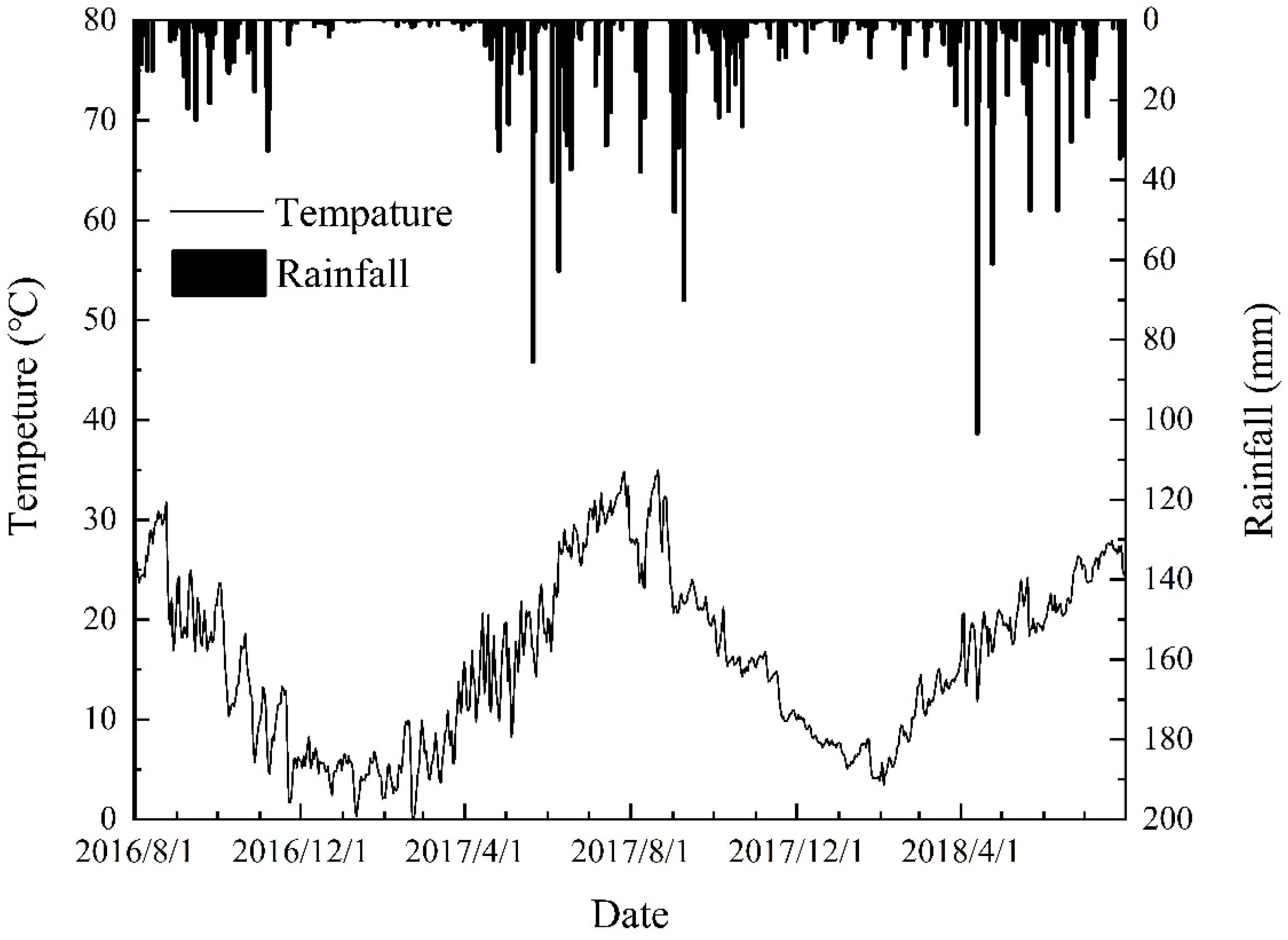
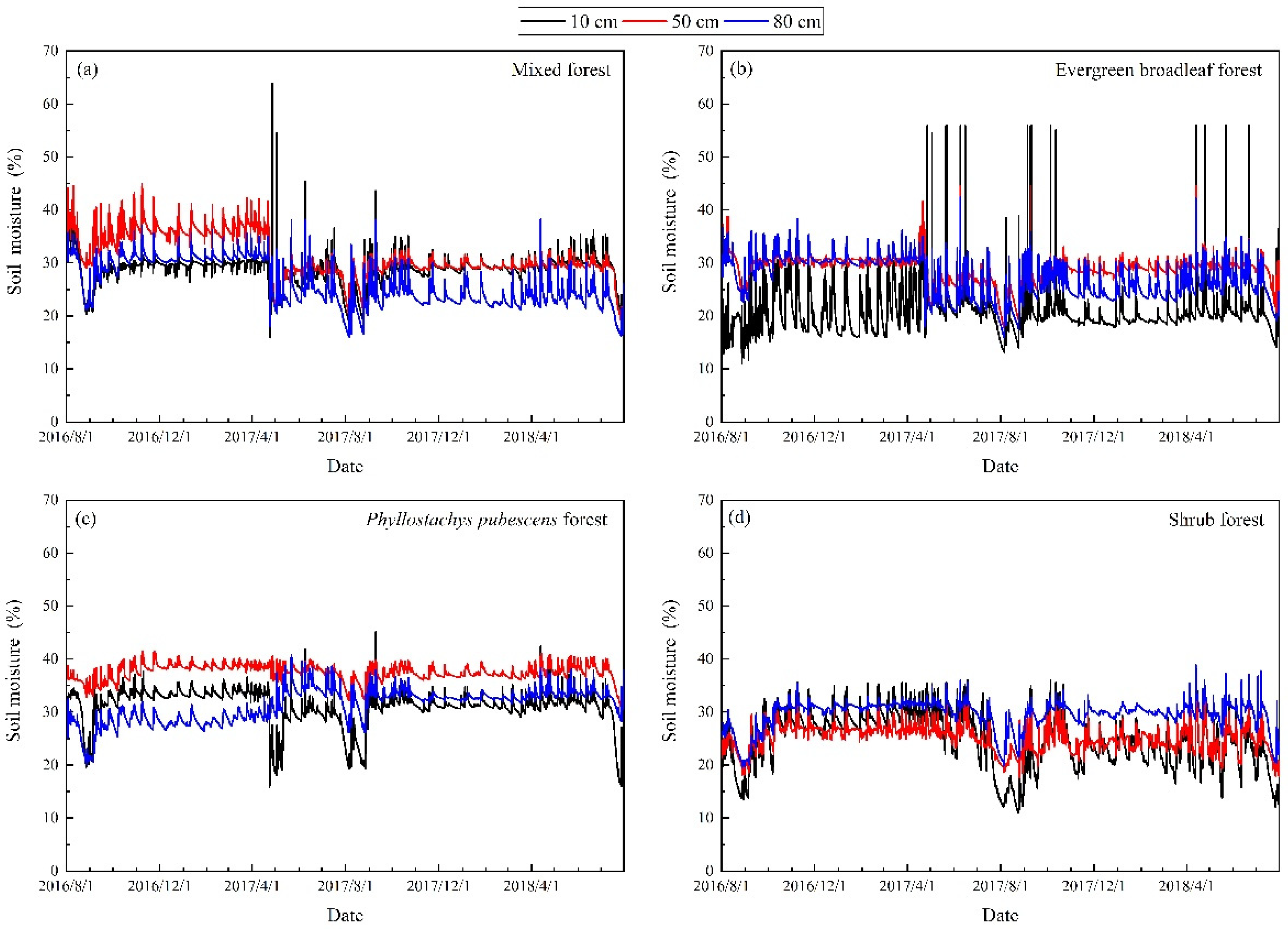
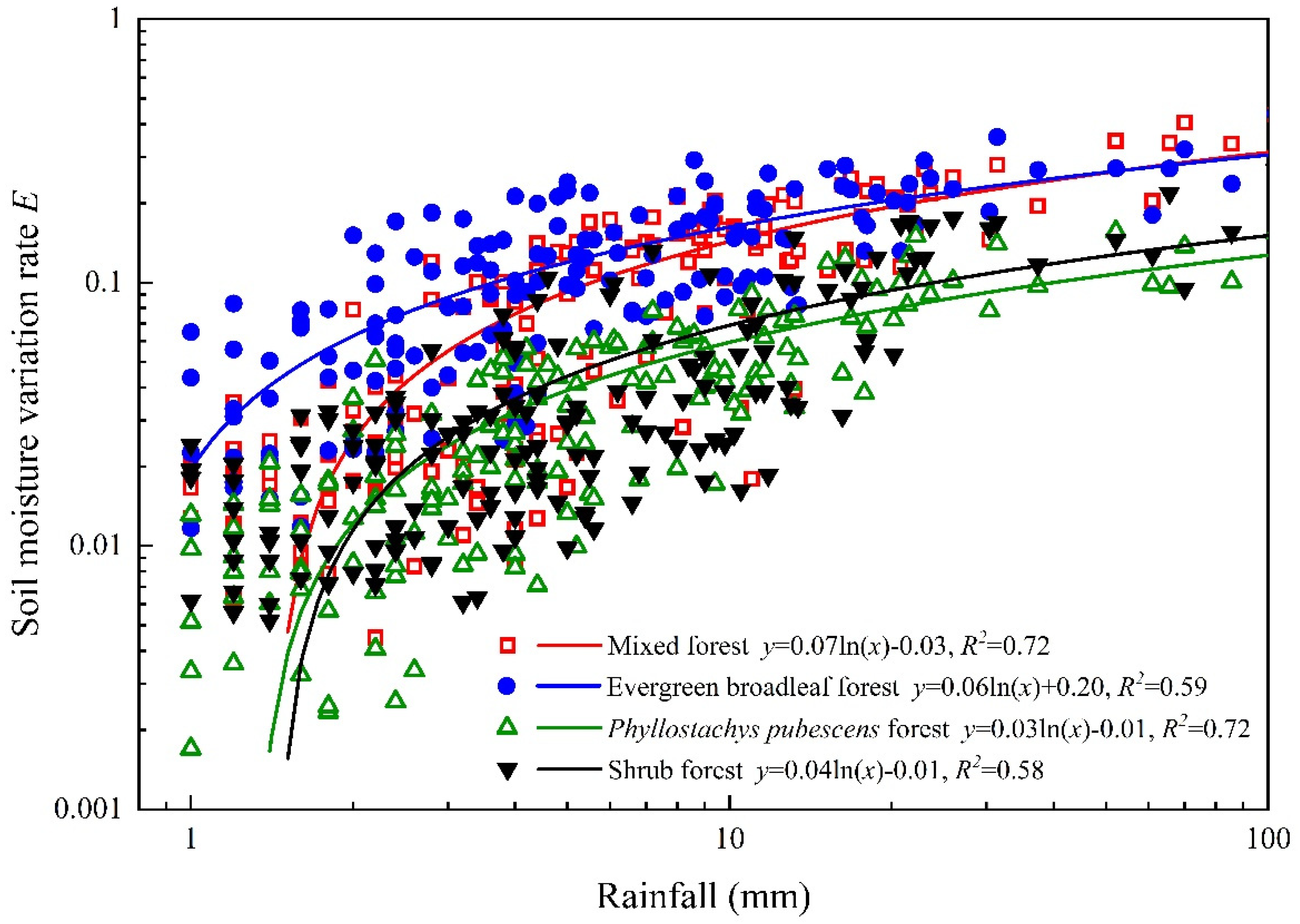
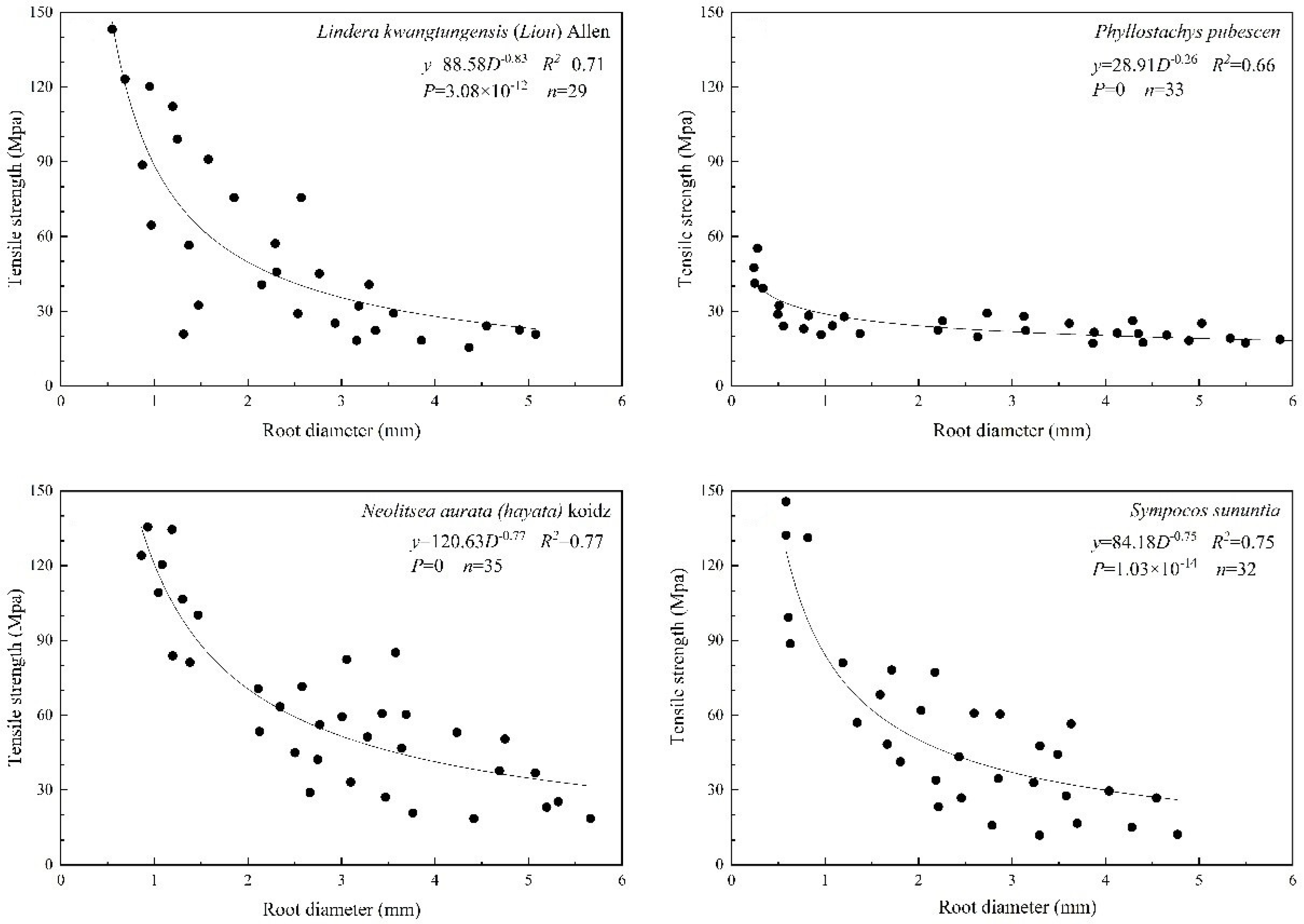
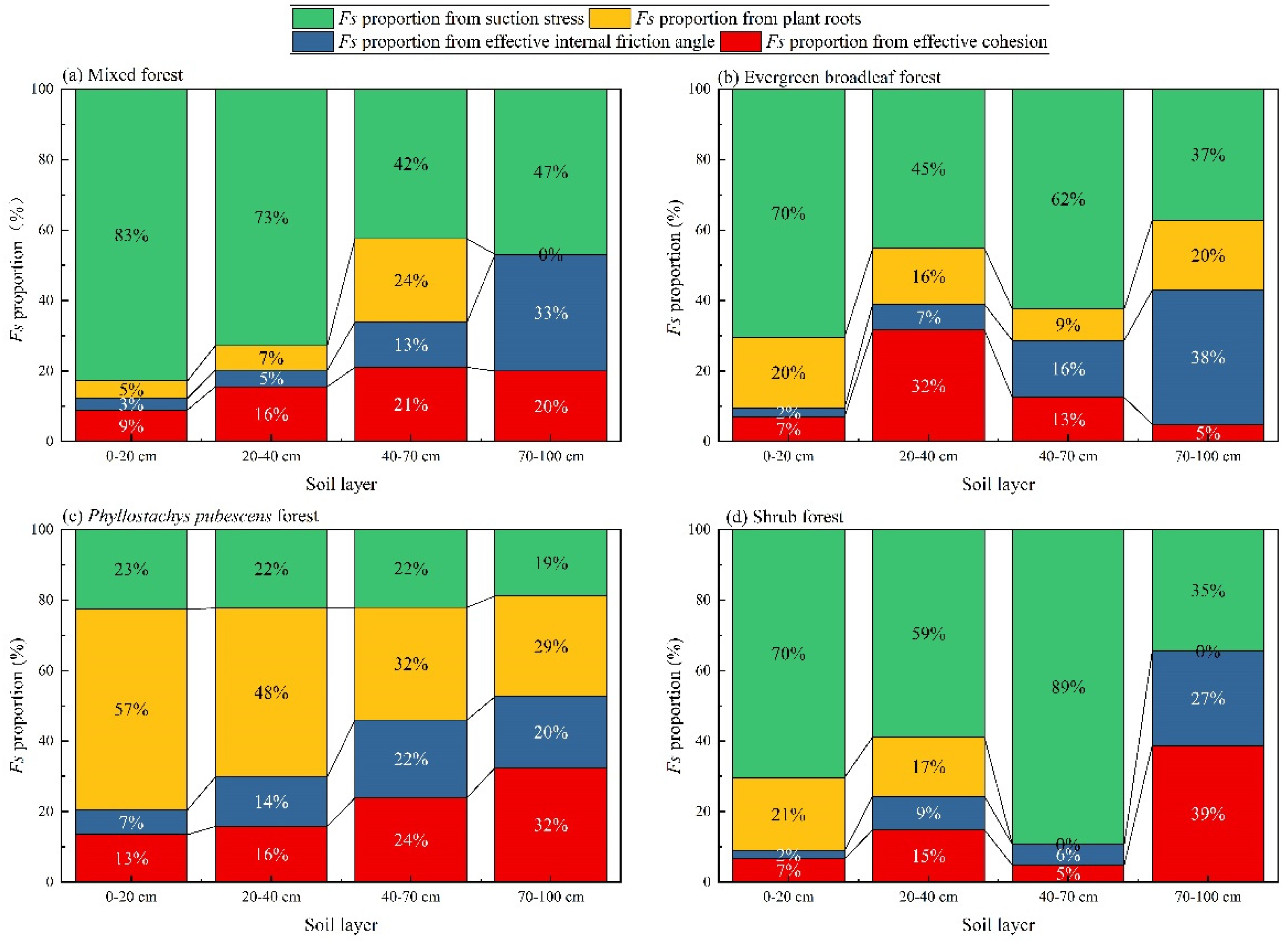
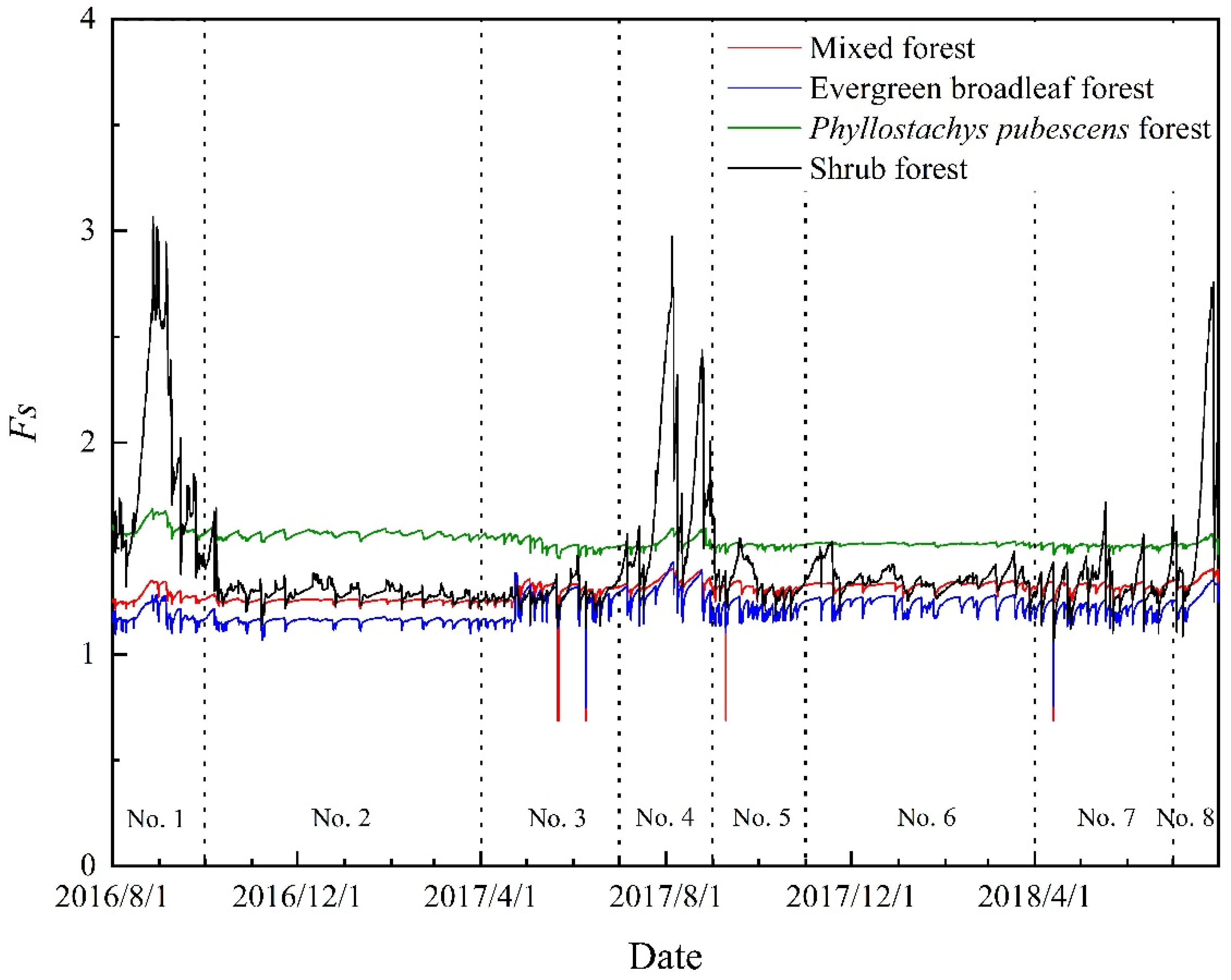
| Physical Property | Soil Layer | Mixed Forest | Evergreen Broadleaf Forest | Phyllostachys pubescens Forest | Shrub Forest |
|---|---|---|---|---|---|
| Porosity (%) | 0–20 cm | 63.96 ± 5.89 | 55.92 ± 4.14 | 58.52 ± 3.31 | 73.33 ± 4.58 |
| 20–40 cm | 50.42 ± 5.40 | 44.6 ± 4.84 | 47.11 ± 2.75 | 57.85 ± 3.23 | |
| 40–70 cm | 49.43 ± 4.61 | 38.23 ± 4.37 | 45.4 ± 3.83 | 45.29 ± 2.58 | |
| 70–100 cm | 38.14 ± 4.22 | 42.44 ± 4.00 | 43.91 ± 3.61 | 42.35 ± 3.00 | |
| Unit wight (g/cm3) | 0–20 cm | 0.98 ± 0.07 | 1.03 ± 0.06 | 1.21 ± 0.04 | 0.75 ± 0.05 |
| 20–40cm | 1.18 ± 0.07 | 1.16 ± 0.05 | 1.35 ± 0.06 | 0.91 ± 0.11 | |
| 40–70 cm | 1.12 ± 0.04 | 1.26 ± 0.07 | 1.29 ± 0.09 | 1.19 ± 0.07 | |
| 70–100 cm | 1.58 ± 0.06 | 1.54 ± 0.08 | 1.57 ± 0.05 | 1.42 ± 0.05 | |
| Effective cohesion (kPa) | 0–20 cm | 14.74 ± 1.20 | 16.54 ± 1.32 | 13.97 ± 1.18 | 11.35 ± 1.20 |
| 20–40 cm | 33.31 ± 1.88 | 45.65 ± 1.34 | 19.73 ± 1.30 | 16.56 ± 1.76 | |
| 40–70 cm | 30.26 ± 1.30 | 18.31 ± 1.34 | 28.14 ± 1.09 | 21.72 ± 1.99 | |
| 70–100 cm | 23.21 ± 1.21 | 5.18 ± 0.99 | 45.15 ± 1.29 | 45.61 ± 0.64 | |
| Effective internal friction angle (°) | 0–20 cm | 24.80 ± 0.60 | 25.50 ± 1.28 | 26.75 ± 1.75 | 22.39 ± 1.06 |
| 20–40 cm | 19.49 ± 0.64 | 20.77 ± 0.59 | 28.29 ± 1.94 | 25.49 ± 1.03 | |
| 40–70 cm | 21.38 ± 0.78 | 24.12 ± 1.09 | 25.36 ± 2.42 | 28.62 ± 0.23 | |
| 70–100 cm | 23.44 ± 0.46 | 24.78 ± 1.61 | 17.23 ± 2.77 | 20.77 ± 0.92 | |
| Soil water characteristic curves | 0–20 cm | y = 22.37x−0.20 | y = 18.1x−0.22 | y = 9.772x−0.28 | y = 20.47x−0.12 |
| 20–40 cm | y = 23.72x−0.23 | y = 17.26x−0.23 | y = 8.122x−0.33 | y = 18.45x−0.13 | |
| 40–70 cm | y = 18.02x−0.19 | y = 16.38x−0.20 | y = 5.995x−0.40 | y = 24.18x−0.16 | |
| 70–100 cm | y = 5.732x−0.44 | y = 6.942x−0.38 | y = 7.207x−0.40 | y = 17.01x−0.10 |
| Soil Layer | Mixed Forest | Evergreen Broadleaf Forest | Phyllostachys pubescens Forest | Shrub Forest | ||||
|---|---|---|---|---|---|---|---|---|
| RAR (%) | Cr (kPa) | RAR (%) | Cr (kPa) | RAR (%) | Cr (kPa) | RAR (%) | Cr (kPa) | |
| 0–20 cm | 0.04 ± 0.01 | 8.22 ± 1.01 | 0.21 ± 0.02 | 47.65 ± 2.55 | 0.45 ± 0.04 | 59.46 ± 1.69 | 0.19 ± 0.02 | 36.18 ± 3.13 |
| 20–40 cm | 0.10 ± 0.02 | 14.67 ± 2.82 | 0.08 ± 0.01 | 23.06 ± 2.50 | 0.48 ± 0.04 | 56.97 ± 3.70 | 0.04 ± 0.01 | 18.93 ± 1.52 |
| 40–70 cm | 0.22 ± 0.04 | 34.15 ± 4.02 | 0.07 ± 0.02 | 12.88 ± 2.85 | 0.30 ± 0.05 | 37.00 ± 2.79 | - | - |
| 70–100 cm | - | - | 0.10 ± 0.01 | 21.60 ± 2.65 | 0.34 ± 0.03 | 39.59 ± 3.08 | - | - |
| Forest Types | Soil Layer | Safety Factor Contribution by Effective Internal Friction Angle | Safety Factor Contribution by Effective Cohesion | Safety Factor Contribution by Plant Roots | Safety Factor Contribution by Suction Stress | Fs |
|---|---|---|---|---|---|---|
| Mixed forest | 0–20 cm | 0.44–0.47 | 1.09–1.33 | 0.52–0.76 | 0–35.04 | 2.05–37.60 |
| 20–40 cm | 0.34–0.37 | 1.09–1.23 | 0.39–0.63 | 0–12.84 | 2.06–14.82 | |
| 40–70 cm | 0.37–0.41 | 0.60–0.66 | 0.60–0.80 | 0–3.88 | 1.57–5.76 | |
| 70–100 cm | 0.42–0.44 | 0.24–0.28 | 0.00 | 0–0.70 | 0.66–1.42 | |
| Evergreen broadleaf forest | 0–20 cm | 0.45–0.51 | 1.25–1.52 | 3.68–4.18 | 0–32.61 | 5.10–38.82 |
| 20–40 cm | 0.36–0.39 | 1.63–1.75 | 0.70–1.06 | 0–5.62 | 2.69–8.82 | |
| 40–70 cm | 0.42–0.47 | 0.32–0.37 | 0.17–0.29 | 0–4.79 | 0.91–5.92 | |
| 70–100 cm | 0.42–0.50 | 0.07–0.07 | 0.21–0.28 | 0–0.66 | 0.67–1.51 | |
| Phyllostachys pubescens forest | 0–20 cm | 0.46–0.55 | 0.86–1.06 | 3.95–4.21 | 0.94-3.48 | 6.21–9.31 |
| 20–40 cm | 0.50–0.60 | 0.56–0.65 | 1.60–1.87 | 0.77–1.05 | 3.42–4.15 | |
| 40–70 cm | 0.41–0.54 | 0.49–0.54 | 0.61–0.74 | 0.42–0.55 | 1.94–2.37 | |
| 70–100 cm | 0.26–0.38 | 0.48–0.52 | 0.39–0.46 | 0.23–0.41 | 1.41–1.78 | |
| Shrub forest | 0–20 cm | 0.38–0.44 | 1.03–1.32 | 3.44–4.24 | 1.23–139.43 | 6.08–145.42 |
| 20–40 cm | 0.45–0.49 | 0.63–0.81 | 0.76–0.90 | 0.64–10.46 | 2.53–12.62 | |
| 40–70 cm | 0.54–0.55 | 0.39–0.49 | 0.00 | 2.69–22.04 | 3.66–23.04 | |
| 70–100 cm | 0.36–0.40 | 0.54–0.56 | 0.00 | 0.15–2.11 | 1.10–3.07 |
| Phase | Date | Fs |
|---|---|---|
| 1 | 2016.8.1–2016.9.30 | Stronger fluctuation and a peak were observed |
| 2 | 2016.10.1–2017.3.31 | Stable |
| 3 | 2017.4.1–2017.6.30 | Had potential for failure |
| 4 | 2017.7.1–2017.8.31 | Stronger fluctuation and a peak were observed |
| 5 | 2017.9.1–2017.10.30 | Had potential for failure |
| 6 | 2017.11.1–2018.3.31 | Stable |
| 7 | 2018.4.1–2018.6.30 | Had potential for failure |
| 8 | 2018.7.1–2018.7.31 | Stronger fluctuation and a peak were observed |
Disclaimer/Publisher’s Note: The statements, opinions and data contained in all publications are solely those of the individual author(s) and contributor(s) and not of MDPI and/or the editor(s). MDPI and/or the editor(s) disclaim responsibility for any injury to people or property resulting from any ideas, methods, instructions or products referred to in the content. |
© 2023 by the authors. Licensee MDPI, Basel, Switzerland. This article is an open access article distributed under the terms and conditions of the Creative Commons Attribution (CC BY) license (https://creativecommons.org/licenses/by/4.0/).
Share and Cite
Wang, X.; Wang, Y.; Ma, C.; Wang, Y.; Li, T.; Dai, Z.; Wang, L.; Qi, Z.; Hu, Y. The Hydrological and Mechanical Effects of Forests on Hillslope Soil Moisture Changes and Stability Dynamics. Forests 2023, 14, 507. https://doi.org/10.3390/f14030507
Wang X, Wang Y, Ma C, Wang Y, Li T, Dai Z, Wang L, Qi Z, Hu Y. The Hydrological and Mechanical Effects of Forests on Hillslope Soil Moisture Changes and Stability Dynamics. Forests. 2023; 14(3):507. https://doi.org/10.3390/f14030507
Chicago/Turabian StyleWang, Xinhao, Yunqi Wang, Chao Ma, Yujie Wang, Tong Li, Zhisheng Dai, Lijuan Wang, Zihan Qi, and Yue Hu. 2023. "The Hydrological and Mechanical Effects of Forests on Hillslope Soil Moisture Changes and Stability Dynamics" Forests 14, no. 3: 507. https://doi.org/10.3390/f14030507
APA StyleWang, X., Wang, Y., Ma, C., Wang, Y., Li, T., Dai, Z., Wang, L., Qi, Z., & Hu, Y. (2023). The Hydrological and Mechanical Effects of Forests on Hillslope Soil Moisture Changes and Stability Dynamics. Forests, 14(3), 507. https://doi.org/10.3390/f14030507





